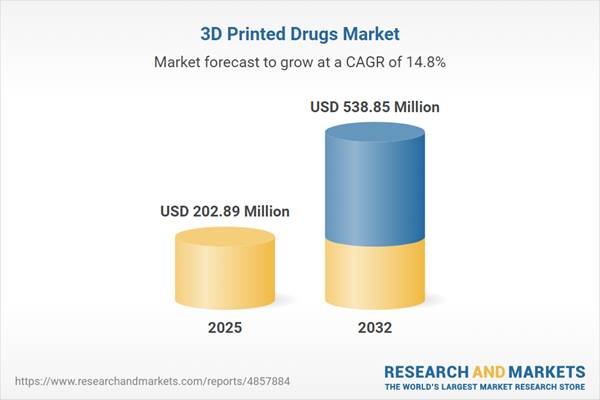Speak directly to the analyst to clarify any post sales queries you may have.
3D printed drugs are transforming pharmaceutical manufacturing by enabling tailored dosage forms and streamlining production for healthcare organizations worldwide. This market is rapidly evolving, driven by advancements in additive manufacturing and the need for greater patient customization in drug delivery solutions.
Market Snapshot: 3D Printed Drugs Market Growth
The 3D printed drugs market grew from USD 178.43 million in 2024 to USD 202.89 million in 2025 and is projected to reach USD 538.85 million by 2032, with a CAGR of 14.81%. This expansion highlights robust adoption of additive manufacturing, reflecting rising demand for personalized medicines and on-demand production capabilities across pharmaceutical sectors.
Scope & Segmentation
This research provides a comprehensive analysis of the global 3D printed drugs market, offering detailed insights into growth drivers, key barriers, and evolving stakeholder strategies. Segmentation covers major technologies, dosage forms, drug release profiles, therapeutic areas, end-user categories, and regional coverage.
- 3D Printing Technologies: Includes fused deposition modeling (nozzle-based and pellet-based), inkjet printing, selective laser sintering, and stereolithography. Each technology serves distinct production requirements, ranging from small-scale rapid prototyping to complex multi-component dosage forms.
- Dosage Forms: Captures capsules, nanoparticles, and tablets, enabling flexibility for precision dosing, targeted delivery, and conventional administration, particularly important for complex therapy regimens.
- Drug Release Profiles: Covers controlled, delayed, and immediate release formulations. These options support diverse therapeutic demands, from sustained efficacy to responsive care in acute scenarios.
- Therapeutic Areas: Encompasses cardiovascular, dental, neurology, and oncology treatments, where precision, combination therapies, and patient adherence are critical for outcomes.
- End User Segments: Addresses contract research organizations, hospitals and clinics, pharmaceutical companies, and research institutes, each leveraging additive manufacturing according to unique workflow and regulatory needs.
- Regional Coverage: Analyzes market opportunities in the Americas; Europe, Middle East & Africa; and Asia-Pacific, factoring in local innovation ecosystems, regulatory climates, and supply chain considerations.
Key Takeaways for Senior Decision Makers
- 3D printed drugs deliver distinct advantages in dosage customization, improving patient adherence and opening new paths in precision medicine.
- Digital manufacturing significantly minimizes inventory pressures and reduces supply chain vulnerabilities, giving healthcare institutions adaptive capability during demand shifts.
- The convergence of material science and software innovation, such as photopolymer chemistry and advanced nozzle designs, expands the toolbox for drug formulation, supporting both immediate and complex release profiles.
- Evolving regulatory frameworks now accommodate additive manufacturing, providing guidance on digital governance and quality validation to streamline pathways from concept to clinical application.
- Collaborative business models, integrating industry, academic, and clinical stakeholders, underpin efforts to accelerate innovation and cut time to market for novel therapeutics.
- Strategic partnerships and modular, scalable production platforms support both centralized and decentralized printing hubs, enhancing supply chain resilience and operational efficiency.
Tariff Impact and Mitigation Strategies
Effective 2025, new United States tariffs on additive manufacturing components and materials are expected to raise procurement costs for domestic pharmaceutical producers. These policies pose challenges around equipment investment and margin management. In response, industry leaders are exploring domestic sourcing, near-shoring, development of local photopolymer formulations, and adopting circular economy models with recyclable feedstocks to mitigate supply risks and promote sustainable operations.
Methodology & Data Sources
Findings are grounded in a hybrid research approach combining primary interviews with pharmaceutical and technology experts and rigorous secondary analysis. Sources include peer-reviewed journals, patent databases, and regulatory guidance documents, ensuring comprehensive validation and triangulation of insights.
Why This Report Matters
- Delivers actionable intelligence for executives and decision makers seeking to optimize production agility and meet evolving patient needs with 3D printed therapeutics.
- Enables stakeholders to benchmark strategies, assess competitive positioning, and identify high-potential investment opportunities across technologies and regions.
Conclusion
The 3D printed drugs market is set to reshape pharmaceutical innovation, driven by technology integration, collaborative ecosystems, and adaptive regulatory support. Organizations ready to invest in scalable platforms and partnerships will be best positioned to unlock new value along the drug development pathway.
Additional Product Information:
- Purchase of this report includes 1 year online access with quarterly updates.
- This report can be updated on request. Please contact our Customer Experience team using the Ask a Question widget on our website.
Table of Contents
3. Executive Summary
4. Market Overview
7. Cumulative Impact of Artificial Intelligence 2025
Companies Mentioned
The companies profiled in this 3D Printed Drugs market report include:- 3D Systems, Inc.
- Aprecia Pharmaceuticals, LLC
- Anatomics Pty Ltd.
- Curify Ltd
- 3D Bioprinting Solutions Ltd
- Cyfuse Biomedical K.K.
- FabRx Ltd.
- GlaxoSmithKline Plc
- Laxxon Medical Corp.
- MB Therapeutics
- Merck KGaA
- Proto Labs Inc.
- Renishaw PLC
- Siemens AG
- Triastek, Inc.
- Yissum
Table Information
| Report Attribute | Details |
|---|---|
| No. of Pages | 186 |
| Published | November 2025 |
| Forecast Period | 2025 - 2032 |
| Estimated Market Value ( USD | $ 202.89 Million |
| Forecasted Market Value ( USD | $ 538.85 Million |
| Compound Annual Growth Rate | 14.8% |
| Regions Covered | Global |
| No. of Companies Mentioned | 17 |









